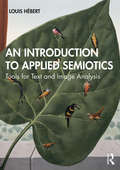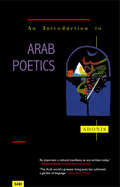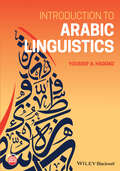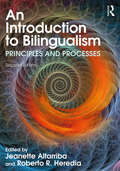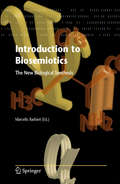- Table View
- List View
Introduction to Afrofuturism: A Mixtape in Black Literature & Arts
by DuEwa M. FrazierIntroduction to Afrofuturism delivers a fresh and contemporary introduction to Afrofuturism, discussing key themes, understandings, and interdisciplinary topics across multiple genres in Black literature, film, and music. From Afrofuturism’s origins to the present, this critical volume features scholarly works, poetry, drama, and creative nonfiction which illuminates on the contributions of notable Afrofuturists such as Octavia Bulter, Sun Ra, N.K. Jemisin, Janelle Monáe, Nnedi Okorafor, Saul Williams, Prince, and more. The volume highlights the impact of films such as Black Panther (2018, 2022), The Woman King (2022), and They Cloned Tyrone (2023) and covers a variety of essential topics giving students a comprehensive view of the legacy of storytelling and the tradition of “remixing” in Black literature and arts. This volume makes connections across academic subject areas and is an engaging reader for pop culture and media film studies, women’s, gender, and sexuality studies, Black and Africana studies, hip-hop studies, creative writing, and composition and rhetoric.
Introduction to Afrofuturism: A Mixtape in Black Literature & Arts
by DuEwa M. FrazierIntroduction to Afrofuturism delivers a fresh and contemporary introduction to Afrofuturism, discussing key themes, understandings, and interdisciplinary topics across multiple genres in Black literature, film, and music. From Afrofuturism’s origins to the present, this critical volume features scholarly works, poetry, drama, and creative nonfiction which illuminates on the contributions of notable Afrofuturists such as Octavia Bulter, Sun Ra, N.K. Jemisin, Janelle Monáe, Nnedi Okorafor, Saul Williams, Prince, and more. The volume highlights the impact of films such as Black Panther (2018, 2022), The Woman King (2022), and They Cloned Tyrone (2023) and covers a variety of essential topics giving students a comprehensive view of the legacy of storytelling and the tradition of “remixing” in Black literature and arts. This volume makes connections across academic subject areas and is an engaging reader for pop culture and media film studies, women’s, gender, and sexuality studies, Black and Africana studies, hip-hop studies, creative writing, and composition and rhetoric.
An Introduction to Applied Linguistics: From Practice to Theory (Second Edition) (PDF)
by Alan DaviesThis second edition of the foundational textbook An Introduction to Applied Linguistics provides a state-of-the-art account of contemporary applied linguistics. The kinds of language problems of interest to applied linguists are discussed and a distinction drawn between the different research approach taken by theoretical linguists and by applied linguists to what seem to be the same problems. Professor Davies describes a variety of projects which illustrate the interests of the field and highlight the marriage it offers between practical experience and theoretical understanding. The increasing emphasis of applied linguistics on ethicality is linked to the growth of professionalism and to the concern for accountability, manifested in the widening emphasis on critical stances. This, Davies argues, is at its most acute in the tension between giving advice as the outcome of research and taking political action in order to change a situation which, it is claimed, needs ameliorisation. This dilemma is not confined to applied linguistics and may now be endemic in the applied disciplines. The book has been updated throughout and provides an excellent introduction to the problems and issues that arise in the practice of applied linguistics.
An Introduction to Applied Linguistics (A hodder Arnold Publication)
by Norbert SchmittAn Introduction to Applied Linguistics, Second Edition provides a complete, authoritative and up-to-date overview of the state of the field. Each of the 15 chapters offers an extended survey of a central element of Applied Linguistics and is co-authored by two leading international specialists, thus ensuring a full and balanced treatment of the topic covered. The book is divided into three sections: a description of language and language use; essential areas of enquiry; and the four skills and testing. An Introductory chapter familiarises readers with key issues and recurrent themes whilst hands-on activities and further reading sections for each chapter encourage practical analysis and wider reading. For this new edition, each chapter has been fully revised in line with new research and thinking in Applied Linguistics. With its accessible style, broad coverage and practical focus, this book is ideal for students of applied linguistics, TESOL, and second language pedagogy as well as practicing teachers and researchers wishing to update their knowledge.
An Introduction to Applied Linguistics
by Norbert SchmittAn Introduction to Applied Linguistics, Second Edition provides a complete, authoritative and up-to-date overview of the state of the field. Each of the 15 chapters offers an extended survey of a central element of Applied Linguistics and is co-authored by two leading international specialists, thus ensuring a full and balanced treatment of the topic covered. The book is divided into three sections: a description of language and language use; essential areas of enquiry; and the four skills and testing. An Introductory chapter familiarises readers with key issues and recurrent themes whilst hands-on activities and further reading sections for each chapter encourage practical analysis and wider reading. For this new edition, each chapter has been fully revised in line with new research and thinking in Applied Linguistics. With its accessible style, broad coverage and practical focus, this book is ideal for students of applied linguistics, TESOL, and second language pedagogy as well as practicing teachers and researchers wishing to update their knowledge.
An Introduction to Applied Linguistics
by Norbert Schmitt Michael RodgersAn Introduction to Applied Linguistics provides a complete, authoritative and up-to-date overview of the state of the field. Divided into three sections covering: a description of language and language use; essential areas of enquiry; and the four skills and testing, the Third Edition of this highly successful textbook provides: an introductory chapter which familiarises readers with key issues and recurrent themes; an extended survey of a central element of Applied Linguistics over 17 chapters; 2 brand-new chapters on Multilingualism and Forensic Linguistics; hands-on activities and further reading sections for each chapter, encouraging practical analysis and wider reading; revised and updated references in every chapter. Authored by leading international specialists and with its accessible style, broad coverage and practical focus, this book is ideal for students of applied linguistics, TESOL, and second language pedagogy as well as practicing teachers and researchers wishing to update their knowledge.
An Introduction to Applied Linguistics
by Norbert Schmitt Michael RodgersAn Introduction to Applied Linguistics provides a complete, authoritative and up-to-date overview of the state of the field. Divided into three sections covering: a description of language and language use; essential areas of enquiry; and language skills and assessment, the third edition of this highly successful textbook provides: • an introductory chapter which familiarises readers with key issues and recurrent themes; • 17 chapters offering extended surveys of central elements of applied linguistics; • two brand-new chapters on multilingualism and forensic linguistics; • re-written chapters on psycholinguistics, language learners, reading and assessment; • hands-on activities and further reading sections for each chapter, encouraging practical analysis and wider reading; • revised and updated references for every chapter. Co-edited by two leading international specialists, with its accessible style, broad coverage and practical focus, this book is ideal for students of applied linguistics, TESOL, and second language pedagogy, as well as practicing teachers and researchers wishing to update their knowledge.
An Introduction to Applied Semiotics: Tools for Text and Image Analysis
by Louis HébertAn Introduction to Applied Semiotics presents nineteen semiotics tools for text and image analysis. Covering a variety of different schools and approaches, together with the author’s own original approach, this is a full and synthetic introduction to semiotics. This book presents general tools that can be used with any semiotic product. Drawing on the work of Fontanille, Genette, Greimas, Hébert, Jakobson, Peirce, Rastier and Zilberberg, the tools deal with the analysis of themes and action, true and false, positive and negative, rhythm narration and other elements. The application of each tool is illustrated with analyses of a wide range of texts and images, from well-known or distinctive literary texts, philosophical or religious texts or images, paintings, advertising and everyday signs and symbols. Each chapter has the same structure – summary, theory and application – and includes exercises and discussion questions, making it ideal for course use. Covering both visual and textual objects, this is a key text for all courses in semiotics and textual analysis within linguistics, communication studies, literary theory, design, marketing and related areas.
An Introduction to Applied Semiotics: Tools for Text and Image Analysis
by Louis HébertAn Introduction to Applied Semiotics presents nineteen semiotics tools for text and image analysis. Covering a variety of different schools and approaches, together with the author’s own original approach, this is a full and synthetic introduction to semiotics. This book presents general tools that can be used with any semiotic product. Drawing on the work of Fontanille, Genette, Greimas, Hébert, Jakobson, Peirce, Rastier and Zilberberg, the tools deal with the analysis of themes and action, true and false, positive and negative, rhythm narration and other elements. The application of each tool is illustrated with analyses of a wide range of texts and images, from well-known or distinctive literary texts, philosophical or religious texts or images, paintings, advertising and everyday signs and symbols. Each chapter has the same structure – summary, theory and application – and includes exercises and discussion questions, making it ideal for course use. Covering both visual and textual objects, this is a key text for all courses in semiotics and textual analysis within linguistics, communication studies, literary theory, design, marketing and related areas.
An Introduction to Arab Poeti
by AdonisPoetry is the quintessence of Arab culture. In this book, one of the foremost Arab poets reinterprets a rich and ancient heritage. He examines the oral tradition of pre-Islamic Arabian poetry, as well as the relationship between Arabic poetry and the Qur'an, and between poetry and thought. Adonis also assesses the challenges of modernism and the impact of western culture on the Arab poetic tradition. Stimulating in their originality, eloquent in their treatment of a wide range of poetry and criticism, these reflections open up fresh perspectives on one of the world's greatest - and least explored - literatures. 'The most intellectually stimulating of several Arab books of unique literary distinction in fine translations ... Translated with uncommon intelligence ... As important a cultural manifesto as any written today.' Edward Said, Independent on Sunday 'Adonis's only prose work available in English is this book. The loss is ours and it is massive, for Adonis is a writer like Neruda or Marquez.' Geoff Dyer, Independent 'Introduces the reader to a new way of interpreting all poetry, and to many marvellous words that do not have an English equivalent.' Arts Letter
Introduction to Arabic Linguistics
by Youssef A. HaddadA comprehensive introduction to the linguistic fundamentals of modern Arabic, ideal for Arabic language learners as well as speakers interested in developing a richer understanding of language use and behavior Introduction to Arabic Linguistics presents a clear and engaging overview of the core linguistic aspects of modern Arabic, focusing on Modern Standard Arabic and Levantine Arabic. Designed to be welcoming for undergraduates without fluency in Arabic and for students with only limited familiarity with linguistics, this textbook covers all fundamental areas of Arabic linguistics. Detailed yet accessible chapters include comprehension and analysis questions, critical thinking exercises, application examples with authentic data, reading assignments, and classroom and homework projects. This valuable textbook is organized into three units which cover sounds and sound systems, word structure and meaning, and phrases and phrase structure. Author Youssef Haddad draws from both the Arabic grammatical tradition and recent linguistic research to provide students with a solid foundation in the linguistic features and structures of Arabic sounds, words, and phrases. Topics include phonological processes, derivational morphology, noun and verb phrases, sentence structure, structural ambiguity, and more. Discusses key topics in the formal study of Arabic linguistics, suitable for Arabic speakers and language learners Encourages students to investigate a dialect not covered in the book at different levels of linguistic analysis Answers many of the most common and relevant questions in the field of Arabic linguistics Includes a typological and historical overview of the Arabic language Offers an instructor’s website with additional exercises, practice questions, PowerPoint presentations, and answer keysIntroduction to Arabic Linguistics is the perfect textbook for undergraduates in modern language and linguistic courses and a valuable resource for graduate students in Arabic studies or linguistics programs.
Introduction to Arabic Linguistics
by Youssef A. HaddadA comprehensive introduction to the linguistic fundamentals of modern Arabic, ideal for Arabic language learners as well as speakers interested in developing a richer understanding of language use and behavior Introduction to Arabic Linguistics presents a clear and engaging overview of the core linguistic aspects of modern Arabic, focusing on Modern Standard Arabic and Levantine Arabic. Designed to be welcoming for undergraduates without fluency in Arabic and for students with only limited familiarity with linguistics, this textbook covers all fundamental areas of Arabic linguistics. Detailed yet accessible chapters include comprehension and analysis questions, critical thinking exercises, application examples with authentic data, reading assignments, and classroom and homework projects. This valuable textbook is organized into three units which cover sounds and sound systems, word structure and meaning, and phrases and phrase structure. Author Youssef Haddad draws from both the Arabic grammatical tradition and recent linguistic research to provide students with a solid foundation in the linguistic features and structures of Arabic sounds, words, and phrases. Topics include phonological processes, derivational morphology, noun and verb phrases, sentence structure, structural ambiguity, and more. Discusses key topics in the formal study of Arabic linguistics, suitable for Arabic speakers and language learners Encourages students to investigate a dialect not covered in the book at different levels of linguistic analysis Answers many of the most common and relevant questions in the field of Arabic linguistics Includes a typological and historical overview of the Arabic language Offers an instructor’s website with additional exercises, practice questions, PowerPoint presentations, and answer keysIntroduction to Arabic Linguistics is the perfect textbook for undergraduates in modern language and linguistic courses and a valuable resource for graduate students in Arabic studies or linguistics programs.
Introduction to Arabic Natural Language Processing (Synthesis Lectures on Human Language Technologies)
by Nizar Y. HabashThis book provides system developers and researchers in natural language processing and computational linguistics with the necessary background information for working with the Arabic language. The goal is to introduce Arabic linguistic phenomena and review the state-of-the-art in Arabic processing. The book discusses Arabic script, phonology, orthography, morphology, syntax and semantics, with a final chapter on machine translation issues. The chapter sizes correspond more or less to what is linguistically distinctive about Arabic, with morphology getting the lion's share, followed by Arabic script. No previous knowledge of Arabic is needed. This book is designed for computer scientists and linguists alike. The focus of the book is on Modern Standard Arabic; however, notes on practical issues related to Arabic dialects and languages written in the Arabic script are presented in different chapters. Table of Contents: What is "Arabic"? / Arabic Script / Arabic Phonology and Orthography / Arabic Morphology / Computational Morphology Tasks / Arabic Syntax / A Note on Arabic Semantics / A Note on Arabic and Machine Translation
An Introduction to Audio Description: A practical guide (Translation Practices Explained)
by Louise FryerAn Introduction to Audio Description is the first comprehensive, user-friendly student guide to the theory and practice of audio description, or media narration, providing readers with the skills needed for the effective translation of images into words for the blind and partially-sighted. A wide range of examples – from film to multimedia events and touch tours in theatre, along with comments throughout from audio description users, serve to illustrate the following key themes: the history of audio description the audience the legal background how to write, prepare and deliver a script. Covering the key genres of audio description and supplemented with exercises and discussion points throughout, this is the essential textbook for all students and translators involved in the practice of audio description. Accompanying film clips are also available at: https://www.routledge.com/products/9781138848177 and on the Routledge Translation Studies Portal: http://cw.routledge.com/textbooks/translationstudies/.
An Introduction to Audio Description: A practical guide (Translation Practices Explained)
by Louise FryerAn Introduction to Audio Description is the first comprehensive, user-friendly student guide to the theory and practice of audio description, or media narration, providing readers with the skills needed for the effective translation of images into words for the blind and partially-sighted. A wide range of examples – from film to multimedia events and touch tours in theatre, along with comments throughout from audio description users, serve to illustrate the following key themes: the history of audio description the audience the legal background how to write, prepare and deliver a script. Covering the key genres of audio description and supplemented with exercises and discussion points throughout, this is the essential textbook for all students and translators involved in the practice of audio description. Accompanying film clips are also available at: https://www.routledge.com/products/9781138848177 and on the Routledge Translation Studies Portal: http://cw.routledge.com/textbooks/translationstudies/.
An Introduction to Biblical Greek Grammar (PDF): Elementary Syntax and Linguistics
by Dana M. HarrisAn Introduction to Biblical Greek Grammar focuses on the linguistic and syntactic elements of Koine Greek to equip learners for accurate interpretation. Drawing upon twenty years of Greek teaching experience and the latest developments in linguistics and syntax, Harris introduces students to basic linguistic concepts and categories necessary for grasping Greek in ways that are clear and intuitive. This solid foundation enables students first to internalize key concepts, then to apply and build upon them as more complex ideas are introduced. Several features are specifically designed to aid student's learning: Key concepts are graphically coded to offer visual reinforcement of explanations and to facilitate learning forms and identifying their functions Key concepts are followed by numerous examples from the Greek New Testament Students learn how to mark Greek texts so that they can begin to "see" the syntax, identify the boundaries of syntactic units, and construct syntactic outlines as part of their preaching or teaching preparation Four integrative chapters, roughly corresponding to the midterms and final exams of a two-semester sequence, summarize material to date and reinforce key concepts. Here students are also introduced to exegetical and interpretive concepts and practices that they will need for subsequent Greek studies and beyond. "Going Deeper" and "For the Curious" offer supplemental information for students interested in learning more or in moving to advanced language study. The accompanying workbook and video lectures (both sold separately) reinforce key concepts through additional contact with the material from each chapter of the grammar. All exercises in the workbook are taken from the Greek New Testament and the Septuagint and include extensive syntactical and exegetical notes to aid students.
An Introduction To Biblical Greek Workbook: Elementary Syntax And Linguistics
by Dana M. Harris Chi-Ying WongAn Introduction to Bilingualism: Principles and Processes
by Jeanette Altarriba Roberto R. HerediaThe study of bilingualism and all of its aspects – from theory and models to social approaches and their practical applications – forms the cornerstone of the 2nd edition of this work. The chapters cover the latest advancements in the domains of psycholinguistics, neuroscience, creativity, and executive functioning. Contributions, new to this edition, offer the reader the most up-to-date research on lifespan and developmental issues. The work also provides insight into how human language is processed by all, not just by bilingual and multilingual speakers.This text is ideal for senior undergraduate and graduate courses in psycholinguistics and the psychology of language, especially those with an emphasis on bilingualism or second language learning.
Introduction to Bilingualism
by Charlotte HoffmannAn Introduction to Bilingualism provides a comprehensive review of the most important aspects of individual and societal bilingualism, examining both theoretcial and practical issues.At the level of the individual, it addresses such questios as: What is involved in the study of bilingual children? What are the patterns of bilingual language acquisition? In which ways do the language competence and the speech of bilinguals differ from those of monolinguals? Topics that sometimes arouse controversy are explored - such as the question of whether there is a relationship between bilingualsim and a child's cognitive, psychological and social development.The book is also concerned with multilingualism, that is, bilingualsim as a societal phenomenon. It focuses on such issues as language choice in bilingual and multilingual communities, national identity and the education of bilinguals. The inclusion of several case studies of European linguistic minorities serves to exemplify the topics dealt with at the theoretical level and to illustrate the linguistic complexities found in contemporary Europe.
Introduction to Bilingualism
by Charlotte HoffmannAn Introduction to Bilingualism provides a comprehensive review of the most important aspects of individual and societal bilingualism, examining both theoretcial and practical issues.At the level of the individual, it addresses such questios as: What is involved in the study of bilingual children? What are the patterns of bilingual language acquisition? In which ways do the language competence and the speech of bilinguals differ from those of monolinguals? Topics that sometimes arouse controversy are explored - such as the question of whether there is a relationship between bilingualsim and a child's cognitive, psychological and social development.The book is also concerned with multilingualism, that is, bilingualsim as a societal phenomenon. It focuses on such issues as language choice in bilingual and multilingual communities, national identity and the education of bilinguals. The inclusion of several case studies of European linguistic minorities serves to exemplify the topics dealt with at the theoretical level and to illustrate the linguistic complexities found in contemporary Europe.
An Introduction to Bilingualism: Principles and Processes
by Jeanette Altarriba and Roberto R. HerediaThe study of bilingualism and all of its aspects – from theory and models to social approaches and their practical applications – forms the cornerstone of the 2nd edition of this work. The chapters cover the latest advancements in the domains of psycholinguistics, neuroscience, creativity, and executive functioning. Contributions, new to this edition, offer the reader the most up-to-date research on lifespan and developmental issues. The work also provides insight into how human language is processed by all, not just by bilingual and multilingual speakers.This text is ideal for senior undergraduate and graduate courses in psycholinguistics and the psychology of language, especially those with an emphasis on bilingualism or second language learning.
Introduction to Bilingualism (Macmillan Modern Linguistics)
by Christina SchelletterDrawing together linguists' and psychologists' approaches to the study of bilingualism, this innovative and engaging volume provides students with a firm grounding in bilingual acquisition and development. It begins with a discussion of sequential and simultaneous bilinguals, illustrated by a wealth of case studies and examples, and the key theories surrounding bilingual development. The book subsequently explores topics such as bilingual speech perception, sound, lexical and morpho-syntactic development, cognitive processing and metalinguistic awareness.Introduction to Bilingualism is an essential companion for undergraduate and postgraduate students of Applied Linguistics, Psycholinguistics, Speech and Language Therapy and Language Education.
Introduction to Bilingualism (Macmillan Modern Linguistics)
by Christina SchelletterDrawing together linguists' and psychologists' approaches to the study of bilingualism, this innovative and engaging volume provides students with a firm grounding in bilingual acquisition and development. It begins with a discussion of sequential and simultaneous bilinguals, illustrated by a wealth of case studies and examples, and the key theories surrounding bilingual development. The book subsequently explores topics such as bilingual speech perception, sound, lexical and morpho-syntactic development, cognitive processing and metalinguistic awareness.Introduction to Bilingualism is an essential companion for undergraduate and postgraduate students of applied linguistics, psycholinguistics, speech and language therapy and language education.>
Introduction to Biosemiotics: The New Biological Synthesis
by Marcello BarbieriCombining research approaches from biology, philosophy and linguistics, the field of Biosemiotics proposes that animals, plants and single cells all engage in semiosis – the conversion of objective signals into conventional signs. This has important implications and applications for issues ranging from natural selection to animal behavior and human psychology, leaving biosemiotics at the cutting edge of the research on the fundamentals of life. Drawing on an international expertise, the book details the history and study of biosemiotics, and provides a state-of-the-art summary of the current work in this new field. And, with relevance to a wide range of disciplines – from linguistics and semiotics to evolutionary phenomena and the philosophy of biology – the book provides an important text for both students and established researchers, while marking a vital step in the evolution of a new biological paradigm.
An Introduction To Book History
by David Finkelstein Alistair McCleeryThis is a comprehensive introduction to books and print culture which examines the move from the spoken word to written texts, the book as commodity, the power and profile of readers, and the future of the book in an electronic age.




